Discussed in this post: gumiho, the Hyeon Joong Gi, male gumiho, Shin Don, Gang Gam Chan, eunhye, evening primrose, fox devotion, foxlike intelligence, fox beads, doongap, fox tails, golden eyes, mind tricks, bewitchment, other abilities, cheonho, mountain gods, liver consumption, Yeou Nui, the desire to be human.
If you’ve found this page, chances are you know what a gumiho is. The hanja (九尾狐) literally mean ‘nine-tail-fox’ — which I believe technically disqualifies Shin Joo, who only has one (though we’ll talk about him a bit, too). Gumiho are one of the better-known creatures of Eastern lore, not only in Korea but in China, where the tales originate, and in Japan as well. That being said, there are notable differences in how each of these cultures characterizes them. I’m planning to write a post about classic fox lore beyond the scope of TotNT, so I’ll try not to get too bogged down in that here.
I will say that the oldest record of a nine-tailed fox is found in the Chinese Classic of Mountains and Seas (c. 400~200 BCE), which mentions “a beast with the appearance of a fox with nine tails. The sound it makes is like that of a young child, and it frequently preys on people.”* Korea seems to have taken this description to heart, as the vast majority of Korean fox lore depicts them as beautiful, bewitching women who eat men’s livers (or hearts, depending on the tale). This isn’t always the case, however, which I’ll be discussing below.
*n.b. I’m working off the Korean here rather than the original Classical Chinese, so this constitutes indirect translation.The Hyeon Joong Gi (玄中記)
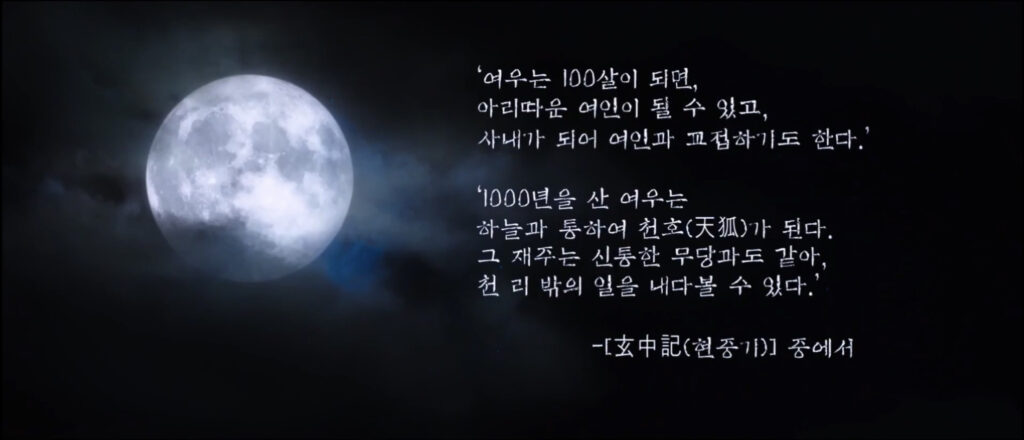
More relevant to the world of TotNT, however, is the Hyeon Joong Gi, which originated in China sometime during the Western Jin Dynasty (266-316 CE). This is the text quoted at the top of EP01, which I would translate as follows:
“When a fox becomes 100, it can become a beautiful woman, or become a man who has relations with women. A fox that lives for 1000 years communes with the heavens and becomes a cheonho (celestial fox). Its gifts are like that of a powerful shamaness; it can perceive things more than 1000 leagues* distant.”
*lit. 1000 li
~ EP01 (玄中記)
This is actually slightly different from the Korean translation I turned up in my research, which reads:
“It is said that when a fox surpasses 50 it can change its form into that of a woman, and if it becomes 100 it can change its form into that of a beautiful girl or a shamaness. It can also transform into a man and have sexual relations with women. Further, it is able to know what is taking place at a great distance and bewitch people. Once it becomes 1000 and communes with the heavens, it becomes a cheonho, the highest level of fox.”
~ Hyeon Joong Gi (玄中記)
You can see that there are commonalities but some of the information has been conveyed differently in each translation – unsurprising, perhaps, given that the source text is over fifteen hundred years old.
I should mention briefly that, despite often being cast in an unflattering light, gumiho are sometimes considered shinsu (神獸) i.e. divine beasts, rather than yogwe (妖怪) i.e. yōkai/monsters, and are said to possess mystical powers. We certainly see a bit of that from Yeon, and from Rang, as well, to a lesser degree. The general consensus is, the older the fox, the more powerful. (Though TotNT claims bloodlines have something to do with it, as well).
The part of this excerpt most relevant to TotNT, however, remains the same in both versions: gumiho can also assume male form.
At the TotNT press conference, director Kang Shin Hyo stated that the idea for the show’s premise actually evolved out of asking what would happen if they told a hero story about a gumiho, but made him male rather than female (as gumiho are normally thought to be in Korea). He shared the thought process he went through with writer Han Woo Ri while planning the series:
“If there are female gumiho, wouldn’t there have been males, too?’ Just as Beom-ie ssi said*, in the reference materials there were these sorts of stories as well. ‘Well then, if there was a male gumiho, he could have fallen in love.’ ‘Couldn’t he have also loved a human?’ ‘Would it have worked out?’ ‘There’s no way it would have.’ ‘Then, wouldn’t he be waiting?’ ‘Then, how would a gumiho living hidden in the present-day feel (what sort of heart would he possess) and how would he live [while] waiting for someone?’ Well, I think this was the place from which we started.”
*n.b. Kim Beom (Lee Rang) actually alluded to the same passage I’ve translated above.
~ Director Kang Shin Hyo, 2020.10.07 Press Conference
So the entire idea for Tale of the Nine Tailed actually came from questioning this preconception of gumiho being female, which they did out of a desire to fundamentally change the classic narrative. The result of posing this question is Yeon: a male gumiho living in modern-day Seoul hunting down yogwe that disturb the peace. Certainly, he’s a character unlike any we’ve seen before, full of dichotomies and charming idiosyncrasies. But it begs the question: leaving aside the matter of Gu Family Book (2013)...how rare are male gumiho, really?
Male Gumiho (남성 구미호)

Tale of the Nine Tailed features two male gumiho – three if we count Shin Joo. And, of course, Yeon and Rang’s father would have been a gumiho, as well. While writer Han Woo Ri has diverged from traditional lore in places throughout the drama, it’s abundantly clear she’s done her research. There are little lore and mythology chestnuts sprinkled throughout that make watching the series more fun if you can spot them. In addition to the excerpt from the Hyeon Joong Gi, the script mentions two historical figures rumoured to be foxes: Shin Don and Gang Gam Chan.
Shin Don (신돈)
Ji Ah: So then, Shin Don...is it a fact that the Goryeo monk Shin Don was a fox? (EP02)
As the chyron informs us, ‘In A History of Goryeo, there’s record of Shin Don, a monk from the time of King Gongmin’s reign, having been an old fox.’ To expand a bit on this, Shin Don (1323-1371 CE) was a real historical figure, born to the concubine of a nobleman in the Goryeo territory of Yeongsan-hyeon. He was both a monk and, later, a statesman who advised the king. As Ji Ah mentions, he’s been referred to as a ‘nohojeong’ (老狐精), meaning ‘old-fox-spirit.’ Some say it was because, despite being a monk, he was overfond of drink and women, but in A History of Goryeo there’s a passage that reads:
“Shin Don feared hunting dogs and hated hunting, was lustful, consumed ogye (black chicken) and white horse every day, and was bursting with vigor, so people called him an old fox spirit. ...As soon as Shin Don died, rumours circulated that an old fox with nine tails had vomited blood and expired in the forest behind the Royal Palace.”
~ A History of Goryeo, vol. 112, pg. 22
In the drama, Yeon neither confirms nor denies the rumors, but I’m taking his shrug as a yes.
Gang Gam Chan (강감찬)
The second mention of a male gumiho (or first, chronologically speaking) actually occurs in a deleted scene that would have been in EP01. Based on the dialogue, this scene would have been set after Yeon and Ji Ah cross paths at the hospital, but before she ‘borrows’ the animal anaesthetic from Shin Joo’s vet clinic (in yet another deleted scene). When giving Ji Ah and Jae Hwan the run-down on Fox Ridge, Sae Rom makes mention of Gang Gam Chan:
Sae Rom: Okay. I did some digging into Fox Ridge. Mt. Gwanak is right near here, right? Apparently, this was once a premier fox habitat. According to one legend, when General Gang Gam Chan was passing by here once, he [?] a fox. (DS 2.3)
Gang Gam Chan (948~1031 CE), like Shin Don, was a real historical figure. He was a government official and military commander famous for his victories during the Third Goryeo-Khitan War. Gam Chan was born in what is today Gwanak-gu, Seoul, but his birth site has another name: Nakseongdae (落星垈) meaning ‘fall-star-site’ or ‘place where the stars fell.’ According to legend, when an envoy asked around about the starfall that occurred at the time of his birth and heard that a baby had been born there, he sought the child out, believing he would go on to do great things. And indeed, he did. General Gam Chan is one of the more renowned military commanders in the history of the Korean Peninsula — on par with Admiral Yi Sun Shin — despite never having received military training.
There’s another legend about his birth, however. Some say that his father, a prominent Goryeo aristocrat, was fond of drink and once spent the night at a tavern with a coy young woman. When he woke the next morning, the tavern was gone, and he returned home in confusion. Months passed, until one night he heard the sound of a fox crying and went to investigate. What he found was a fox at the site where the tavern had stood, and beside her a human baby. This child, of course, was Gang Gam Chan. The father took the baby home and raised him, but it was said that the boy was uncommonly gifted, being the child of a fox.
There are more legends associated with him, even ones that include other foxes and (in one case) King Yeomra himself, but I won’t get into that here since it probably deserves its own post. It tickles me that the writer actually found precedent for a male half-gumiho and slyly dropped it in, though. It’s a shame the scene ended up being cut.
Fiction vs. Fable
So, we’ve established that, despite popular conception, there is precedent for male foxes in Korean lore and that the writer cleverly incorporated some of these into her script. But just how much is precedent? Which elements of the Tale of the Nine Tailed have their basis in traditional fables, and which elements are entirely new? Let’s start by unpacking the mythos that is unique to TotNT.
Eunhye (은혜)
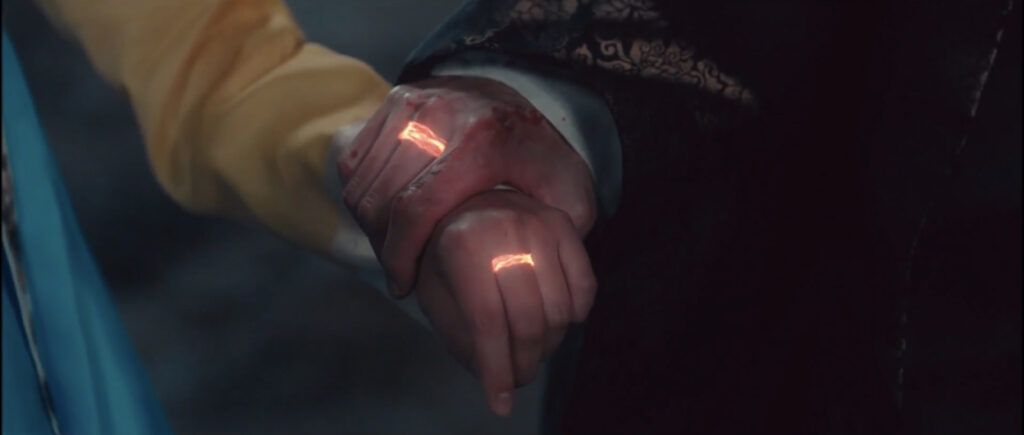
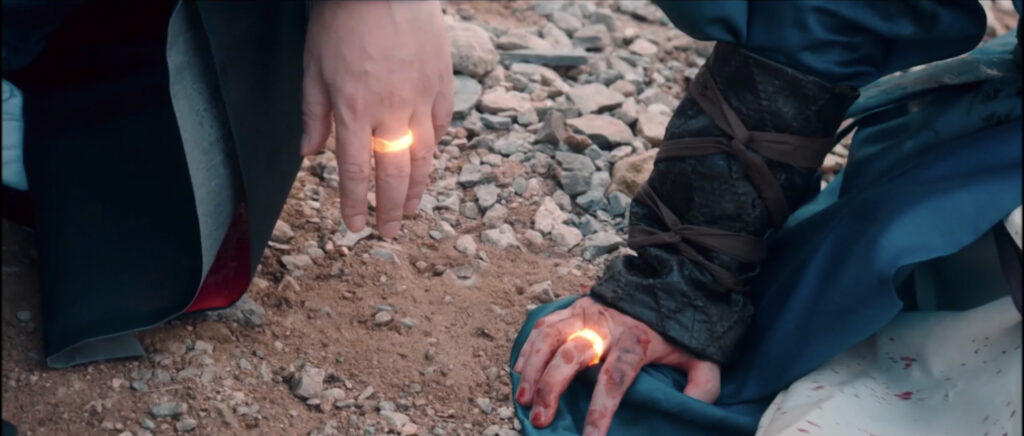
Yeon: We repay what’s owed. It’s old fashioned but romantic.* It’s also a fox’s dignity.
Shin Joo: It can also be a curse. Since the greater the eunhye we incur, the more it [becomes] a spell rendering us into puppets. (EP02)
Azeria unpacked eunhye a bit in a previous Ask, but I’ll explain it briefly here for anyone that missed it. While often translated as ‘favour’ or ‘debt,’ neither is strictly accurate conceptually. Eunhye is essentially ‘something owed in exchange for a good turn.’ It features prominently in the folktale The Grateful Magpies (은혜 갚은 까치), which Shin Joo alludes to in the above conversation.
Foxes in the world of TotNT are cosmically bound to repay the eunhye they incur, however large or small — which is why Yeon’s fur gets all ruffled when he’s given an extra scoop of his beloved mint chip ice cream in EP01. It’s eunhye that binds Rang to the Traitor, and eunhye that ultimately seals Yeon and Ah Eum’s fate. The firey rings are a manifestation of this contractual relationship.
In the context of the drama, this is framed as a sort of divine check against foxes’ power. When Rang seeks out Taluipa looking for a way to escape his eunhye bond, she tells him:
Taluipa: In ages past, when god bestowed you lot with more gifts than humans possess, he added a constraint you cannot get out of. So as to punish arrogant, malignant* foxes like you who trample on humans and kill them. (EP10)
*n.b. The word she uses is ‘oman-bangja’ (오만방자), where ‘bangja’ can mean ‘invoking evil/curses upon [a person]; imprecating; damning.’As far as I’m aware, this bit of lore is entirely unique to Tale of the Nine Tailed – both the idea of eunhye as a supernaturally binding force and its association with foxes.* It reminds me vaguely of the Fair Folk, who can only speak truth and are therefore bound by their word, but I’m so curious as to where the idea originally came from. Was it a reimagining/reattribution of some other bit of lore? Or did it arise out of narrative necessity? Since every hero needs a weakness (or two) to overcome, and it both rationalizes Yeon’s part in Ah Eum’s death and creates dramatic conflict between the brothers. Unfortunately, unless an interview with the writer is included in the Director’s Cut Blu-ray bonus materials, we may never know (and perhaps not even then).
*n.b. There is one tale I found, Hwang Geon Joong and the Court Lady Gwishin (황건중과 궁녀귀신), that mentions both eunhye and a fox, but the eunhye isn’t supernaturally binding and the rumoured fox has already died and become a gwishin, so it’s a stretch.It’s interesting to me that, while foxes in the world of TotNT are bound to repay whatever eunhye they incur, however large or small, the fiery rings only seem to manifest when what’s owed is a life debt. For instance, even though Yeon had a contract with the Ten Kings to repay the eunhye of restoring Ah Eum’s soul, we don’t see a firey ring dissipate when the contract is ended. I mention this because it’s one of the few things in this story that doesn’t quite add up for me: if Yeon had, as we know, dealt Rang an intentionally non-lethal blow, then the Traitor didn’t actually save his life (because he wasn’t truly dying). Ergo, Rang shouldn’t have owed him a life debt. And yet, Rang was very clearly bound. The only way I can make sense of this is that Rang’s natural lifespan was finite (as we know it to be), so the debt isn’t from having ‘saved’ him after his run-in with Yeon, but for having unnaturally extended his life into the present day. This, however, fails to explain why the rings manifested when they did. Like I said, it doesn’t quite add up.
Evening Primrose (달맞이꽃)
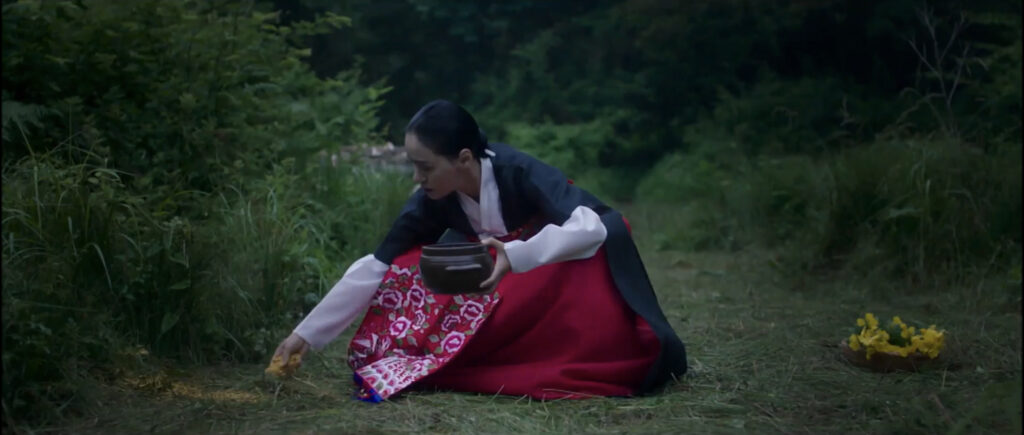
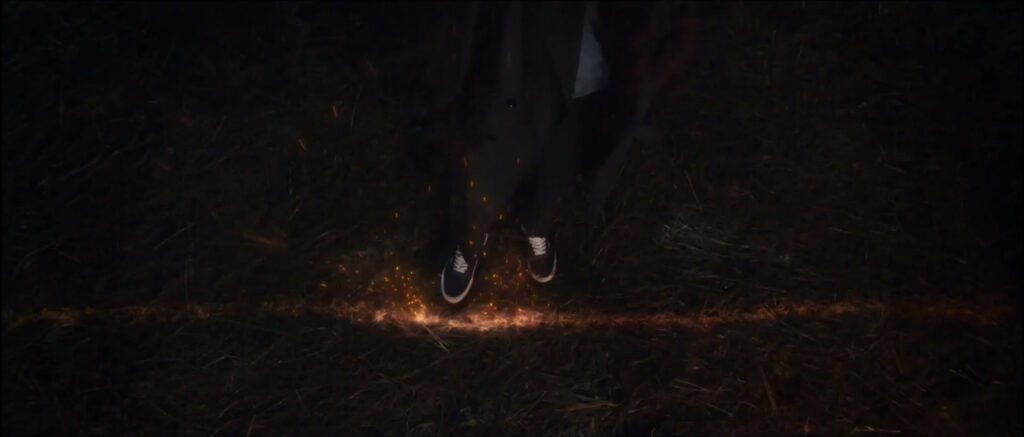
Rang: Leave Lee Yeon to me. You go to the burial ground and collect evening primrose that has grown on the the flesh and blood of corpses. (EP03)
The other critical weakness of gumiho in the world of TotNT is their susceptibility to evening primrose — or, more properly, ‘burial ground evening primrose’ (묘지의 달맞이꽃). The ‘burial ground’ part consistently got dropped in the subs due to space and timing constraints, but it’s an important distinction. As stated in the tvN term deck, “Evening primrose that has grown feeding on the blood and flesh of corpses is the same as poison to gumiho; if they so much as touch its powder, their bodies catch flame.” Regular primrose, presumably, wouldn’t have any effect on Yeon.
I’m honestly not sure where the writer got the idea for this particular bit of mythos, but I’m a fan. Maybe the idea that a powerful, nearly invulnerable being can be brought down by something so small and fragile as a flower simply appeals to me. Certainly, it was a great choice cinematographically — those shots of Yeon forcing his way across the firey primrose barrier in EP03 were like something straight out of the old myths (not to mention the only time all series we got to see him in full Gumiho Mode).
We mentioned in our EP03 breakdown that the Korean for evening primrose is ‘dalmajikkot’ (달맞이꽃) meaning, ‘flowers that welcome the moon,’ — the moon being a motif that carries across multiple aspects of the show (the opening title sequence, iconic shots, the OST, etc.). But again, the connection between fox lore and the moon isn’t immediately apparent to me. It could just be that supernatural creatures, in general, are often thought of as belonging to a shadow-world, superimposed upon or hidden beneath the surface of the human one, and the moon is an obvious choice to symbolize that. Or it could be something else entirely; I honestly don’t know.
I did look into evening primrose lore independent of foxes, but the only tales I could turn up were those from other cultures, retold in Korean. There was an interesting degree of similarity to these stories, despite originating from entirely different cultures in different ages. In both of the tales (one Native American, one Greek) a woman passes away after pining for her love for countless nights, and when he finally comes to find her, she’s died and become an evening primrose. The similarities likely stem from the nature of the plant itself: evening primrose is a biennial night-blooming flower. Hence, ‘flowers that welcome the moon’ and their association with waiting. Perhaps because of this, in the Korean language of flowers evening primrose means ‘waiting; fairy of the night; wish.’
Whatever its origin, it’s a fun addition to the gumiho canon.
Only One (평생배필)


Yeon: Once a fox takes a mate they never forsake them. Until death. (EP01)
This is yet another new addition to gumiho lore. While some of the old tales (and many of the more modern re-imaginings) do centre around themes such as enmity and love, the gumiho isn’t normally cast as the hopelessly devoted party. Nor are natural red foxes known to be faithful to one mate throughout their lives (though grey and arctic foxes sometimes are). However, in the world of TotNT, foxes are loyal to their chosen partner unto death — and beyond, in Yeon’s case. Shin Joo’s proposal to Yoo Ri in EP16 affirms this:
Shin Joo: Foxes love only one mate their whole lives. Will you receive my love until death?* (EP16)
*n.b. This doesn’t come across as morbid in Korean.Since Rang doesn’t have a romantic interest (which I actually appreciated, personally), we don’t know how that would have played out for his character, being half-fox. However, Kim Beom weighed in on the matter in his IG LIVE:
“I saw someone say something like this: When Yeon-ie hyung falls in love it’s to this extent (i.e. he’s this head-over-heels), so if Rang-ie, who’s a rule-breaker, who ignores all the rules, were to fall in love, the earth would probably have been destroyed. Or at the very least, Korea would have been destroyed (laughs). Someone said that, but I think that probably would have been the case. If he had directed his love not at his hyung, but at a woman, because Rang-ie isn’t afraid of his hyung, or the Afterlife, or hell itself, I feel like he would have had that sort of [world-ending] romance.”
~ Kim Beom, 2020.12.01 IG LIVE
So, there you have it: TotNT foxes — hopeless romantics.
Past and Present
That about covers the lore that’s unique to Tale of the Nine Tailed (other than some abilities I’ll be discussing below). But what about the rest of it? The mystical powers and shape-changing and clever ploys? Could an old fox really go toe-to-toe with a proto-dragon? Could a monster become a god?
Clever Fox (영리한 여우)



The Traitor: The problem is whether that bastard will just meekly sit back and let you put him to sleep.
Yeon: I’ll just make him meekly sit back and take it, then. (EP12)
Yeon’s character profile mentions “extraordinary intelligence befitting a fox,” (여우답게 영특한 지능) and this is in keeping with the old tales. Like in Western lore, Korean foxes have a reputation for being clever tricksters and TotNT definitely delivers on this front. We see multiple instances of Yeon mentally outmanoeuvring his opponents and playing mind games to achieve his ends (the EP09 Eodukishini sequence and the EP11 doongap sequence being prime examples of this), and he’s often several steps ahead of the other characters, with the possible exception of Imoogi.
He can even be a bit ruthless for the sake of strategy. As the backstory collection revealed, Yeon decided to personally hunt Rang down and deal him an intentionally non-lethal blow to prevent another enforcer from actually killing his brother. And I don’t doubt that he would have been willing to lethally wound Ji Ah in order to evict Imoogi, so long as Taluipa agreed to restore her. He’s ruthless with himself, as well, as we see in EP13 when he intentionally lets Jimoogi stab him so he can gauge her(?) strength. He’s the oldest of our foxes, and it shows in his cunning and long-lens on life.
Yeon also plays a number of ‘foxlike’ tricks throughout the drama: hiding Rang’s shoes to force his brother to use Yeon’s own charmed pair in EP06, or passing off a cheap wooden blade from a local flea market for the legendary Uiryeong-geom in EP13. The idea of passing off one item for another and using it to trick the unsuspecting is a common motif in fox lore. From passing off a bewitched cowskin as a fine cloak to passing oneself off as another person entirely (i.e. doongap, which I’ll talk about more below).
The Fox Bead (여우구슬)
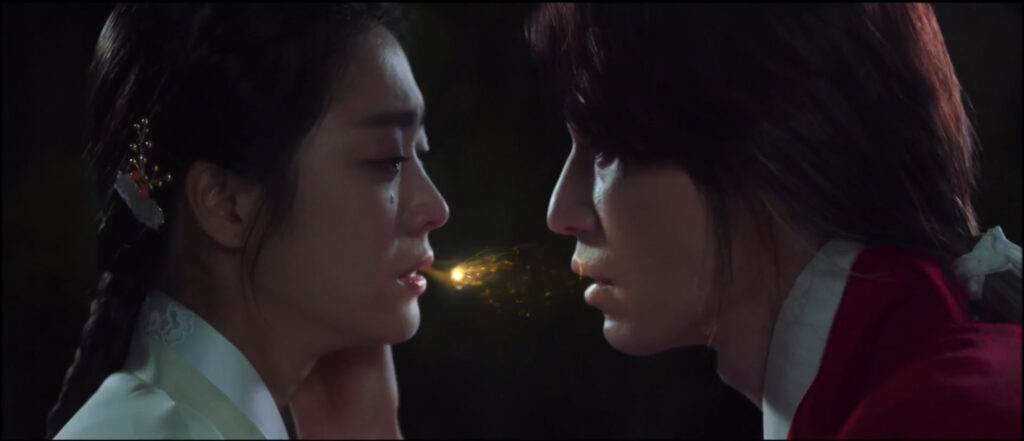


Lee Yeon (VO): Several times I met similar faces...but none of them carried the fox bead I’d given her. (EP02)
We can’t talk about gumiho – or TotNT, for that matter – without mentioning fox beads. In the context of the show, this is the magical ‘marker’ Yeon entrusts to Ah Eum so that he’ll be able to identify her when she’s reborn, as well as the power that suppresses Imoogi inside of Ji Ah (until she trades it away, that is). tvN published a brief explanation of it via their Twitter account that reads:
“Ji Ah, whom Yeon believed would be Ah Eum’s reincarnation, did not have the fox bead Yeon gave to his first love, Ah Eum, before she died. Regardless of this fact, as soon as Ji Ah fell into mortal peril, Yeon dragged his wrecked body, covered in wounds from his punishment, [to her] and saved her. As soon as Ji Ah shed tears over Yeon’s sacrifice, his fox bead hidden within her appeared, proving she was Ah Eum reborn. Fox beads, as cintamani stones (여의주) held withing a gumiho’s mouth, are called ‘the treasure of a fox’s lips,’ and legend says that if you swallow one you’ll gain an understanding of all things and phenomena in the universe.”
~ tvN 1-4화 전통 설화 정리
So that scene of Yeon passing over his fox bead to Ah Eum in EP02 is straight out of the old myths. Because the fox bead was thought to reside in a gumiho’s mouth, it could potentially be gifted (or stolen) via a kiss. This is how the Korean folk hero Jeon Woo Chi was said to have gained his sorcery – by stealing (or, in some versions, being gifted) a fox’s bead.
I believe the legend being referred to in the above explanation might be The Gumiho and the Cintamani Stone (구미호와 여의주), which has several versions and names that share certain commonalities. A young student learns that if he swallows a fox’s bead he’ll gain complete knowledge of the first thing he glimpses thereafter and sets out to steal one so as to learn all the secrets of the heavens. He does manage to steal one – via a kiss, of course – but he trips and the first thing he sees is the ground (earth) instead of the sky (the heavens). There’s another version as well, casting him as the victim, where it’s the gumiho that has to kiss (and suck the life force from) 100 men to become human and the student swallows the bead out of self-preservation (naturally).
The English Wikipedia page claims that Japanese kitsune don’t carry fox beads (狐の玉・狐珠), and while that’s true of the traditional lore, more recent stories have since introduced the concept. In Japan, a fox’s bead is sometimes said to be akin to its life force, but this obviously isn’t the case for Yeon, who’s lived without his for 600+ years.
That being said, it’s unclear whether Yeon’s fox bead is an intrinsic part of him being a gumiho, or if it’s due to his past as a sanshin (mountain god). The following exchange made me think it might be the latter:
Lee Yeon: The Mirror of the Moon. Did you intend to harm* a human with one of the Four Great Sanshin’s Four Great Treasures, which are said to protect all of creation?
Magistrate: Then did your fox bead protect all of creation? Or did it protect one person? (EP06)
*n.b. Yeon uses the word ‘japta’ (잡다), which is literally ‘to catch’ but can be used to mean something closer to ‘kill’ in certain contexts.
This makes it sound as if Yeon’s fox bead (or, potentially, ‘Fox Bead’) is one of the Four Great Treasures, just like the Mirror of the Moon. In which case, other gumiho in the world of TotNT might not have them at all. Our other three foxes aren’t likely to help elucidate this point, either. Rang comes from the same bloodline as Yeon but is only half-fox, while Yoo Ri and Shin Joo only have one tail each, meaning they’re not technically gumiho (gu = nine) at all. (Admittedly, some of the lore claims a fox can be a gumiho even if it doesn’t have all nine tails, but none of the characters in TotNT ever refer to Shin Joo or Yoo Ri as anything other than ‘foxes.’)
Honestly, I still have a tonne of questions about Yeon’s fox bead: its function and powers, what role it played in Yeon’s restoration, and what ultimately became of it (Did it get used up and effervesce? Did it return when his powers did? Does it now live in his umbrella/sword?). I don’t think they’re ever likely to be answered, though, which I suppose leaves us viewers free to decide our own headcanon.
There’s a lot more lore surrounding fox beads – enough that it deserves its own post – but I’m not going to get into it here since this one’s already shaping up to be massively long. For now, I’ll just say, stay tuned for more.
Doongap (둔갑)


Yeon: Foxes, you see, do this thing called doongap. (EP11)
As we mentioned in our EP02 breakdown, doongap literally means ‘to assume the form of,’ which I would argue is conceptually different from ‘transformation’ (변신), though that word does sometimes get used in relation to foxes. However, unlike ‘transform,’ which implies a purely physical change (變身 = ‘change-body’), ‘assuming the form of’ implies a much more complete change. When Rang and Yeon do this, they change not only their physical appearance but their voices, the clothes they’re wearing, potentially even their scents. It’s a complete enough change that Rang thought there was a chance it might get past Taluipa’s all-seeing eye in EP10.
As a side note, there’s a track in the BGM called ‘Transformed’ (변신) but it’s used in scenes related to Imoogi rather than in the doongap scenes with our foxes. It’s not enough of a distinction that I would consider the subs ‘wrong’ per se, but since we’re looking specifically at gumiho lore I thought it was worth noting the difference.
The NamuWiki section on doongap states:
“If one were to pick the most iconic characteristic of fox yogwe, it would be their ability to take on human form. Foxes mainly doongap into beautiful women and bewitch humans, supping on their vital force. As one can tell from the idiomatic phrase ‘bewitched by a fox,’ the image of foxes changing into beautiful women and bewitching people is universal.”
~ 여우 설화: 둔갑 – 나무위키
Honestly, it’s hard to find a fox tale that doesn’t use the word doongap somewhere in the telling, and if you run the word through a Korean dictionary, chances are at least one of the example sentences will include foxes. The ability is that iconic.
Rang’s character profile describes him as ‘skilled at doongap’ (둔갑에 능하다) and indeed, it’s a skill he favours and uses often. In contrast to Rang, who apparently has no qualms about changing into a high-school girl (EP01), or even Yoo Ri (Spinoff EP03), Yeon views the ability as a cheap trick that lessens his dignity as a fox (as opposed to all the other silly things we see him do...? pfft). He is, however, willing to make an exception for Rang’s sake in EP11, leading to one of the more satisfying reversals in the drama.
This is one of the fox abilities we never see Shin Joo or Yoo Ri exhibit. It may be because, not being gumiho, they’re not powerful enough to use this skill (Chinese lore says a fox has to have at least two tails before it can doongap), or it might be a matter of bloodlines, which I’ll talk about below.
Other Attributes & Abilities (기타 특징)
“Two characteristics that manifest when Lee Yeon uses his powers: the golden eyes and flame-like tails.” (tvN terms deck)
Tails (꼬리)


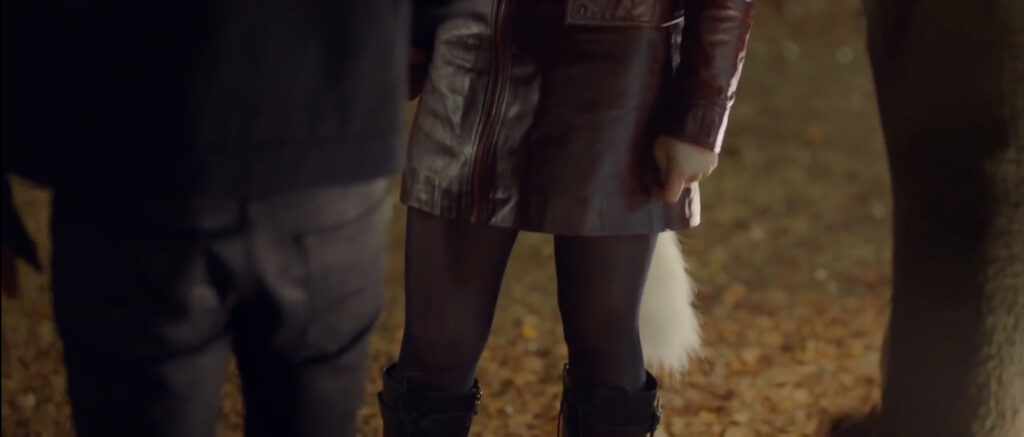
Jae Hwan: Pardon the question, but do you have tails?
Ji Ah: He has them. I’ve seen them. (EP11)
A gumiho’s most iconic (and appellative) characteristic: the nine tails. Little did we know when EP03 aired that it would be the first and last time we got to see Yeon’s tails in all their glory. I was hoping we’d see them at least once more before the series wrapped, since both Yeon and Ji Ah claim she’s seen them, and I can’t see how she might have from inside the well. I guess one of their sleepovers included a gumiho show-and-tell time.
It’s not entirely clear if, as the term deck states, the fiery tails are their true form or if this is simply how they manifest when Yeon is in human form (does he have a fox form?). I’m inclined to believe this is how they look, but azeria is of a different opinion. Admittedly, I don’t see how one could use shampoo on these guys, but then, that teaser interview may or may not be canon.
Kim Beom mentioned in his IG LIVE that they had demoed several different versions of the tails, including actual (physical) tails, to work out what looked the most convincing — which doesn’t surprise me. What does surprise me is that each of our fox’s tails (that we get to see) looks so different. Yeon’s, of course, appear to be made of flame, whereas Shin Joo’s is almost spectral, and Yoo Ri’s is clearly a costume piece.
I can think of a couple of potential reasons for the differences, but it’s pure speculation on my part. Shin Joo has acted as Yeon’s retainer since his Baekdudaegan days, which would make him at least 600 years old, as opposed to Yoo Ri whom Yeon refers to in EP12 as a ‘young, weak fox’ (though, admittedly, ‘young’ is relative when you’re 1636+ years old). So the spectral quality to Shin Joo’s tail might be a function of age. Alternately, it might have something to do with the cause of his gun phobia. In EP03 he mentions his tail having been ‘blown away’ by a hunter’s gun, so another possibility is that this spectral form is all that remains of it. Or, it could be that, unlike Yoo Ri’s tail which still pops out from time to time, Shin Joo’s tail wasn’t actually visible, but Yoo Ri could sense it anyway as a fellow fox. (It could also just be the result of decisions made on the production end of things and nothing to do with the mythology writer Han Woo Ri has crafted at all.)
In traditional lore, the number of tails a fox has is often a function of its age, and therefore a symbol of how powerful it is (since age is often correlated with power in Eastern mythology). That being said, Tamamo-no-Mae, arguably one of the most famous foxes of legend and one of Japan’s Three Great Yōkai, is sometimes said to have had only two tails. This might have something to do with the fact that, according to certain tellings, when a fox becomes a cheonho, the number of tails actually decreases to four, and when they age further and become a gongho (空狐 = sky/air fox; 3000 years old) their tails disappear altogether. This isn’t the case in TotNT, of course. Yeon clearly has all nine of his tails.
It does make me wonder though if Shin Joo and Yoo Ri will ever ‘level up’ and gain more tails, or if they’ll always be as they are now. There were two lines of dialogue that made me suspect it might be the latter:
Yeon: I was the master of Baekdudaegan, a mountain god who controlled the wind and rain, and a gumiho who was, from the start, of a different calibre than the mongrel foxes you see in Hometown of Legends. (EP02)
Shin Joo: In today’s world, foxes that reek of money and power fall into two categories: golden spoons* from prestigious bloodlines like Lee Yeon-nim, or those who violated taboo and stole a human life. (EP03)
*n.b. In Korean, the terms ‘golden spoon’ (금수저) and ‘dirt spoon’ (흙수저) are used to refer to the [socioeconomic] status one is born into. Essentially, the ‘haves’ and ‘have-nots’.
When Yeon gave his little self-introduction at the top of EP02, I initially wondered if he was objecting to the portrayal of gumiho in Hometown of Legends (if he found it campy or unflattering). But Shin Joo’s comment in EP03 made me think that maybe Yeon meant precisely what he said: that he was born of a higher calibre and some of what makes him so powerful is the blood he inherited from his father (and potentially his mother, as well). This may also explain why Rang, despite being only half-fox, is capable of more fox tricks than Shin Joo or Yoo Ri, who are both full foxes — because he inherited that same blood.
According to Chinese legend, half-breed children born of a human and a fox do have tails, but if you don’t cut them off, such children are raised into foxes and disappear into the mountains. If you cut their tails off in time, they grow into remarkably gifted humans who earn great acclaim (such as the above-mentioned General Gang Gam Chan or the famed onmyōji Abe-no-Seimei). Rang is conceivably the former, though we never get the chance to see his tails. Kim Beom, at least, seems to believe Rang has all nine. In his IG LIVE, he said:
“Actually, Lee Rang’s tails have never appeared on screen, but in any case, Lee Rang should also have nine tails, right? There are nine. I have nine tails, but one of those was given to me by hyung. And one by the director, and one by the writer, and many others besides. Because they gave me tails, I was able to become a gumiho with nine tails, that’s the feeling I get. Yes.”
~ Kim Beom, 2020.12.01 IG LIVE
So, nine tails it is. (Also, what an adorable, lovely thing to say).
Golden Eyes (금안)


Ji Ah: What the...? Did you just hypnotize all those people? (EP07)
As we know from the necktie scene in EP07, Yeon’s eyes don’t have to change for him to be able to hypnotise (or even mass-hypnotise) people, but the golden eyes do seem to appear most often when the brothers are Jedi mind-tricking people. They also sometimes make an appearance when Yeon is enraged and/or using his powers (EP03, EP07, EP11), but not consistently so. I actually thought it would have been pretty cool to see Yeon’s eyes go from fox-gold to snake-yellow (or even flicker back and forth) in EP15 after he swallows Imoogi’s scale, but it’s possible that would have been somewhat ambitious on the CG-end of things.
I didn’t find any specific references to a fox’s eyes in the lore I read up on, probably because almost all of the tales are about foxes that doongap into humans, which would include making their eyes appear fully human as well. But I love that they included this detail. In fact, I wish we’d gotten to see a lot more of those gumiho eyes. And tails. More gumiho everything. Again, I’m sure this had more to do with limitations on the post-production end than anything.
As far as behind-the-scenes info on the eyes goes, both Lee Dong Wook (Lee Yeon) and Kim Beom mentioned that they’d tried both coloured contacts and CG, and that the CG ended up looking better. Kim Beom also shared in his IG LIVE that it had been the director’s idea to have only one of Rang’s eyes change, as a nod to his half-fox heritage.
We never see Yoo Ri’s or Shin Joo’s eyes change, nor do they seem to be able to mind-trick people. Yoo Ri resorts to violence in EP04 when her fake father’s memory resurfaces until Rang steps in to re-hypnotise him. And I can only assume Shin Joo might be more blasé about discovery, too, if he could magically wipe people’s memories the way Yeon does.
Magistrate: Have you given your heart to a fox? Or are you merely bewitched? (EP06)
This isn’t a skill strictly related to their eyes, but I’m including it here since it seems closely related to the mind-trick ability. In addition to the ability to doongap, the ability to bewitch humans is probably a gumiho’s most infamous skill and features prominently in the majority of fox lore.
However, while this is alluded to in various promotional materials (Yeon’s character profile, for example, mentions ‘beauty that bewitches people’), we don’t actually see Yeon or Rang bewitch anyone in TotNT – though there was that funny CG comment Sae Rom made in EP05. Rather than an ability they exercise, it seems like they’re just really good looking and that naturally affects people.
That being said, the backstory collection seems to imply that this is, in fact, one of the skills in their fox arsenal, despite neither brother seeming inclined to use it. It’s how Rang was born to a human mother – she’d been bewitched by their father who, unlike Yeon, wasn’t wholly benevolent.
In the tales, the bewitchment is generally a much more active, ill-intentioned thing; one of the skills used in a gumiho’s quest to prey on people. As mentioned in the doongap quote I translated from NamuWiki, ‘bewitched by a fox’ (여우에 홀리다) is an idiomatic phrase in Korean, which shows you how deeply it’s pervaded the cultural consciousness. Since it didn’t really feature in the drama, that’s all I’ll say about it here.
Other (그외)



Yeon exhibits several other abilities throughout the drama not directly related to lore, and it’s not always clear if they’re thanks to him being a gumiho, thanks to him being a cheonho, or thanks to him being a (former) mountain god. I’ve picked out a few that I suspect are more closely related to him being a fox and will talk about the rest in the following two sections.
The mysterious light – When Yeon checks Ji Ah to see if she possesses his fox bead, we see a soft golden light pouring from the cup of his hand. It’s unclear what this light does (other than sense the fox bead) or if it’s an ability only Yeon, as the fox bead’s true owner, possesses.
Vitality – In addition to being amortal and unageing, Yeon recovers at an incredible speed, as we see in EP05. The injuries Shin Joo advises need to be monitored for at least a month are mostly healed in the space of a day. Lee Dong Wook joked that it was because no one would watch a drama where the protagonist was bedridden for umpteen episodes, but I’m inclined to believe this is yet another function of him being a particularly powerful fox. Shin Joo is also amortal and unageing, and recovers fairly quickly after Rang roughs him up in EP07. Yoo Ri is a giant question mark.
We don’t actually know what Rang’s natural lifespan would have been without the ggwari, since he’s only half-fox; if he would have lived a human number of years, or lived longer than a human but aged very slowly. We do know that he’s already lived well beyond his allotted years by the time the drama starts. Despite this, Yeon repeatedly tells Rang not to die young/early, which would be laughable coming from anyone else, considering Rang is over 600. I wonder if it never occurred to him that his half-human brother would have fewer years to live, or if it was enough for Yeon that Rang was alive and he knew better than to question how.
The ability to fly – Ji Ah is fortunate Yeon possesses this particular ability, given the stunt she pulls at the end of EP01. She must have found different materials than I did, since none of the tales I turned up mention gumiho flying. Rang seems to be able to do this as well, given the way Yeon drags him back to the ground in their fight on Eohwa Island.
Superhuman speed – This is a skill both Yeon and Rang exhibit and one Yeon, at least, uses fairly often in his fights with yogwe. Kim Beom talked a bit about the ability in his IG LIVE since fans were apparently wondering why the brothers bothered with cars at all. His response: gumiho can move faster than people, but their legs still get sore and it uses up energy so they drive. heh
Teleportation – In Yeon’s ambush of Imoogi at the end of EP10 and the fight that follows in EP11, we see Yeon do something that looks a lot like teleportation. Lee Dong Wook’s promotional team even included the ability in one of the questions they prepared for the VS game in his 2020.11.18 VLIVE. That being said, this ability is in none of the lore I turned up and we only see him do it once, so I’m not sure if he’s actually teleporting or just moving faster than the human eye can track (which was Kim Beom’s take on it). Given the elevator sequence, I’m actually inclined to believe it’s the former, but that seems a bit extravagant given everything else Yeon can do. Then again, director Kang Shin Hyo stated at the TotNT press conference that Marvel was one of the series’ earliest influences so teleportation might just be par for the course.
Cheonho (천호)

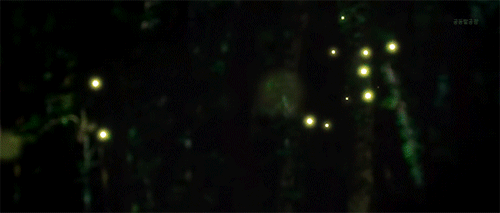

Don’t venture near the northern forest, whatever you do. They say a thousand-year-old fox lives there. (EP10)
Yeon is a cheonho. Which, as we know from the Hyeon Joong Gi excerpt that opened EP01, is a fox that has lived over a thousand years and communed with the heavens. NamuWiki explains the designation as follows:
“A fox that has trained for over a thousand years and risen to the standing of a god. It is said that a fox that becomes a cheonho gains an all-seeing eye that allows it to see things 1000 li hence, and works at the Palace of the Sun (日宮) or the Palace of the Moon (月宮) in the heavenly realm. In Japan, they’re sometimes regarded in the same light as tengu.”
~ 여우 설화 – 나무위키
So, in fact, Taluipa’s cheollian (千里眼; ‘thousand-li-eye’) — what the subs refer to as her ‘clairvoyance’ or ‘all-seeing eye’ — is a reattribution of a power originally said to belong to cheonho. (But I’ll get into that more when I do a breakdown of the Samdocheon mythology.)
It should be noted, however, that not all foxes that live a thousand years become cheonho. There’s another word in Korean for a fox that lives for a millennium: ‘maegu’ (매구). While often considered to be largely synonymous with ‘gumiho,’ the dictionary defines maegu as “legendary beasts which foxes that live over a thousand years are said to change into.” So, unlike cheonho, which are considered to be some form of deity, maegu are undeniably yogwe. The difference lies in the word ‘training,’ which typically implies not only physical but mental discipline. In other words, only foxes that are essentially benevolent and abide by the edicts of heaven can become cheonho. In Japanese, benevolent foxes are sometimes referred to as ‘zenko’ (善狐), but I haven’t encountered the Korean analogue, ‘seonho’ (선호) — likely because gumiho are mostly thought to be malicious.
Which begs the question, are they gods or monsters? In many of the tales, gumiho are monsters, harbingers of death and misfortune. And yet some are said to rise to the station of gods and tread the heavenly plane. The NamuWiki page on fox lore explains the source of this dichotomy as follows:
“Foxes are highly intelligent beasts who, while being rivals to hunters and shrewd adversaries who make off with livestock, also have the image of being gods of plenty because they eat rats, who damage crops and cause all sorts of malaise.”
~ 여우 설화 – 나무위키
So the contradiction is likely rooted in the paradoxical relationship humans share with ordinary foxes, which no doubt influenced the tales. King Chade of Goguryeo sums the dichotomy up nicely in the History of Three Kingdoms: “If it’s ominous, say it’s ominous; if it’s auspicious, say it’s auspicious. You say it was wicked, but now you say it brings luck; what lie is this?” (참고).
While the confusion is understandable, cheonho fall solidly into the latter category. For instance, there’s record in the Taiping Guangji (925~966 CE) of a cheonho who was worshipped as a god by the people of Silla, and a fox known as Hojosa (狐祖師) is said to be the first cheonho to rise to the station of a higher god or dharma.
That being said, Yeon being a cheonho and his past as a mountain god are two separate things, so I’ve decided to divide them up to make things a bit clearer if I can. Not that the line between these two is always clear to me. Even though Yeon is repeatedly said to be a ‘former’ mountain god, he still seems to be able to draw on the power and authority of his former station when it suits him. I’ve picked out a few abilities below that I think might have more to do with him being a cheonho, but really it’s a toss-up.
Telekinesis – We see Yeon do this twice: in his fight with the Magistrate in EP06 and his confrontation with Taluipa in EP07. And though Yeon refers to Taluipa as ‘a god among gods/a god of gods’ (신들의 신) in EP14, their powers seem pretty well-matched here. (Though, presumably, if Taluipa had gotten serious, she could have just turned him to stone). I didn’t find this ability in any of the old tales, so I assume it’s a new addition to the lore.
Immunity – Yeon seems less susceptible to the abilities of other yogwe in the TotNT ‘verse. He’s able to take control of Eodukshini‘s illusion in EP09, almost like a lucid dreamer might take control of a nightmare, and Yeon is the only one other than Ji Ah who proves impervious to Imoogi’s power of suggestion. Similarly, Yeon states in EP13 that, even if Imoogi were to find a way to possess him, as long as he’s conscious, he isn’t likely to lose control of his body. Finally, even though we see sparks fly when Yeon comes into contact with the burial ground evening primrose in EP03, it takes a while for their effect to hit him when he actually swallows some in EP15. (I’m guessing this last had more to do with narrative necessity than anything.)
Fireflies – Honestly, I have no idea where the idea for this ability came from, but we see Kang Chi do something similar in Gu Family Book (2013), which makes me wonder if there’s something I’m missing. I’m not even sure if they’re meant to be real fireflies Yeon summons, or if they’re more magical than that. I almost filed this under the next section since Yeon invokes his past as a mountain god when he summons them in EP03, but he also sent fireflies to Ji Ah when she was a child (and again in EP05) and he definitely wasn’t a mountain god then, so...toss-up.
Mountain God/Sanshin (산신)



Shaman: The most merciless of the four mountain gods who ruled the land. They say that since none would dare to rashly despoil his forest, Baekdudaegan was perpetually lush and fertile. (EP03)
I saw this translated as ‘mountain spirit’ in a lot of the fansubs going around the internet, which is understandable given that Yeon isn’t a god in the way gods are typically thought of in Western mythology, but the hanja for sanshin (山神) literally mean ‘mountain-god.’ In Eastern mythology, ‘shin’ can be used to refer to anything from a guardian spirit to a greater deity, so the translation ultimately comes down to one’s interpretation.
In Korean shamanism, sanshin are divine spirits (神靈) said to invite good fortune and long life. They’re often depicted in the company of a tiger and a young boy (which explains Yeon’s tiger friend at the top of EP02) and are said to control the wind and rain (i.e. the natural elements). Other names for them include sanshinryeong (山神靈), sanryeong (山靈), sangun (山君), sangi (山祇), sanmanura (山마누라), and yeshin (豫神).
Yeon and the mudang both say that there are four sanshin who control the Korean Peninsula, and I think they’re all mentioned at least in passing. There’s Yeon, of course, and the Magistrate, both of whom appear in the drama itself. The other two are only mentioned in the dialogue: the sanshin of the North whom Taluipa turned into a stone pillar when he(?) went on a rampage, and Shin Joo’s former sanshin who stole Yeon’s egg when they ate noodles together once. Yeon is a fox, and the Magistrate is revealed to be a moon bear, or ‘pandalgom’ (반달곰), but we never do find out what the other two are.
Yeon isn’t the only fox to become a sanshin, however. There are a few of them in Korean lore. In the tale of Palbaek-ie and the Fox (팔백이와 여우), for example, we have a benevolent fox who is vying with a giant centipede over guardianship of the nearby mountain. This tale is actually an exception to many of the tropes of Korean fox lore since, in the end, the fox elects to become human to be with Palbaek-ie, the human who had refused to kill her. It’s one of the few fox tales in which the human and fox get to have their happy ending.
There’s also the tale of The Buddhist Monk Won Gwang and the Sanshin of Mt. Samgi (원광법사와 삼기산(三岐山)의 산신), in which the sanshin is a 3000-year-old black fox who can call down lightning and cause landslides. This is another rare tale in which the fox is wholly benevolent and shares a conversation with the monk before peacefully passing away. The tale is sometimes considered an analogy for the rise of Buddhism and the decline of folk religion in the Korean Peninsula.
Based on the above, I’ve decided to list the following abilities here:
Mastery over the elements – We see multiple instances of Yeon controlling the natural elements, from the rain he summons to wash away the evening primrose in EP03 to the storm system that gathers when he faces off against Imoogi in EP11. He also mentions this ability in his intro at the top if EP02, referring to himself as “a mountain god who controlled the wind and rain.” I’m not entirely sure why he’s still able to do this even after having abdicated his position as a mountain god. Maybe he only relinquished the title?
Thunder and lightning – This could possibly be grouped with the above ability, but when Rang and Yeon are trapped in Eodukshini‘s Forest of the Starved, Yeon lists them off as separate powers. Again, this is something we see him do twice in his post-mountain god days, so it might be this has more to do with him being a cheonho than a former sanshin.
Communicating with plants – This one isn’t exactly confirmed, but we do hear Yeon talk to the tree on Eohwa Island in EP03, and in EP06 he mentions that he likes summer because “it’s the season when the forest becomes most boisterous. Even if I don’t ask after each and every one of them, every flower and tree gets an equal share of sun and wind and rain...” Which kind of makes it sound like he has a way to understand them. It would make sense, I suppose, if part of his job as a mountain god is to care for all that grows and lives in his domain.
Healing – This is an ability we only see Yeon use once: when he heals the broken branch in EP03. I had wondered if we might see it again when Rang seriously roughs up Shin Joo in EP07, but no dice. I know the scene was actually difficult to film and it made the cut when a lot of other scenes got deleted, so obviously it was deemed important. It’s possible it was included to establish something about Yeon’s character more than it was meant to demonstrate his abilities. I’ve included it here because it seems like the sort of skill Yeon would have used during his tenure as a mountain god and because we only see him use it to heal a tree but, again, it’s not made clear where this power stems from or why he doesn’t use it on other occasions.
Freezing time – This is another power we only see Yeon use once, and it’s not clear whether he’s stopping time itself or if he’s using his command over rain to create the effect. Whatever the case, it seems like a pretty high-level skill and we don’t see him do it in his post-mountain god days so I’ve listed it here. Needless to say, this wasn’t in any of the literature.
Liver Consumption (간 먹기)
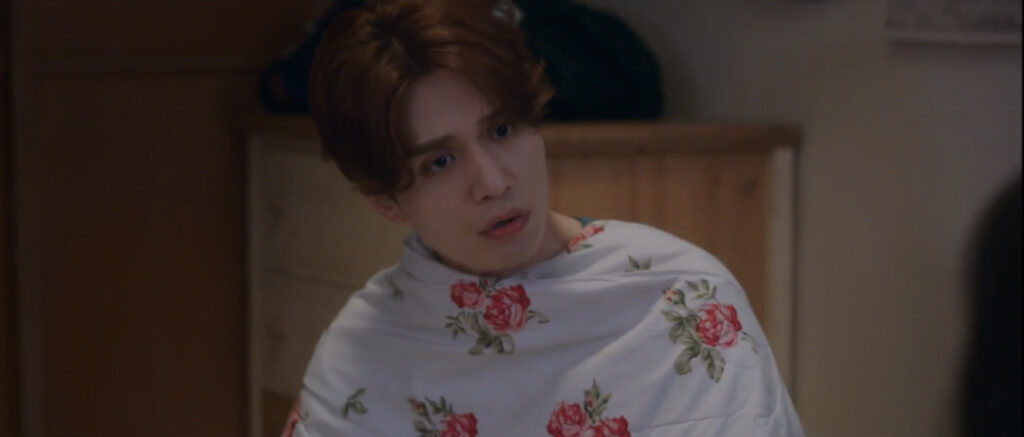

Ji Ah: You said you’re a gumiho. Well, if by any chance you wanted to eat liver or something-
Yeon: I don’t eat that crap! (EP02)
The first record of a fox eating liver appears in the second volume of the Memorabilia of Three Kingdoms (삼국유사) in The Legend of Geotaji (거타지 설화), wherein the fox actually feasts on dragon livers — specifically, the relations of the Dragon King of the Yellow Sea. Since dragons are considered divine beasts and superior in all ways to imoogi, it’s little wonder then that Yeon, an old fox, was able to go toe-to-toe with Imoogi and come out on top.
There are also tales in which foxes eat hearts or human corpses, and even some in which they suck blood, but over time these faded away until liver became the food of choice for foxes in Korean lore. One interesting caveat to this is that, as a general rule, gumiho in possession of fox beads aren’t depicted as eating livers, and gumiho that do eat liver aren’t depicted as having fox beads. This may be because gumiho that have fox beads are sometimes considered closer to Chinese xiān hú (仙狐; ‘sage-fox’) than they are to the more traditional Korean maegu (매구).
Why liver of all things? One explanation is that predators tend to go for the liver first since it’s nutrient-dense. Alternately, Heo Jun’s Dongui Bogam (동의보감) claims that the liver generates vital energy (生氣) and is where the soul resides, making it the ideal food for a monster trying to amass power.
Given this context, it’s little wonder that both Ji Ah and Sae Rom ask Yeon if he eats liver. Yeon, however, hotly denies this, citing the risk of liver fluke (pfft). While that’s certainly something to be avoided, given the literal hell he goes through for smiting the mudang, a human using nefarious means to unnaturally extend her life, I’m inclined to believe there’s more to it than that. For one thing, if Yeon was going around eating people’s livers, he would have been on the Afterlife Bureau’s wanted list instead of acting as their enforcer (and he wouldn’t be a cheonho). For another, Yeon falls into the class of gumiho that possess fox beads, and clearly values human life.
That being said, we know that there are foxes in the world of TotNT that do, in fact, eat liver. Yeou Nui, the fox bride Yeon executes in EP01 is famous for this very thing:
Yeon: Yeou Nui-ya, after eating the livers of countless adoptive parents and older brothers how can you dream of a happy ending? (EP01)
As one of the more infamous yogwe featured in TotNT, Yeou Nui deserves her own post, but I’ll explain briefly here. As we mentioned in our EP01 breakdown, ‘yeou nui’ means ‘fox sister,’ a nod to this yogwe‘s typical MO. In the old tales, she would prey on families with only sons who desperately wanted a daughter, insinuating herself into their lives, eating the livers of their livestock, and bringing calamity down upon them before finally eating her adoptive family (yikes). In many versions of the tale she’s quoted as saying:
“Ha ha elder brother. Hee hee elder brother. Where are you going without eating your meal? (…) A horse for one meal, a person for one meal. I’ve eaten 999 people and I only need to eat one more, but you’re running away. Oh, what a waste! Oh, what a waste!”
~ 여우누이 – 나무위키
When she says she only needs to eat one more, the implication is that she only needs to eat one more liver to become human. More on that below.
To Be Human (인간 되고 싶다)



Yeon: If things which can never be can also be called dreams, I...want to become human. (EP05)
Yeon’s desire to be human is actually very much in keeping with the old tales. While some, like Yeou Nui or the fox in The Gumiho and the Cintamani Stone, seek to achieve this through murderous means, there are other tales in which the method to become human is relatively more benign. For instance, in some tellings, the fox must marry a human and keep her fox nature a secret from him for the first 100 days after their wedding; if she succeeds, the fox becomes human and her husband is left none the wiser.
However, in many cases, marriage to a human is a death sentence for a fox, such as in the tale of The Fox Bride of Seonang Ridge (서낭고개의 여우각시) which, in a nutshell, is the fox version of The Little Mermaid. Faced with the choice between eating her kindly husband’s liver and dying herself, the fox bride chooses death. As I mentioned earlier, tales like Palbaek-ie and the Fox that have happy endings are few and far between.
It should be noted that not all gumiho desire to become human. Some only desire the human seeming (i.e. doongap), while others consider humans inferior life forms, and still others aspire to ascend to the heavenly plane the way imoogi are said to when they become dragons. Yeon is correct, though, that there aren’t many cases of gumiho becoming truly human and living happily ever after. In fact, I could only find the one.
Interestingly, Yeon seemed to be under the impression that becoming human was wholly impossible, which suggests to me that none of the above methods exists in the world of TotNT. And, to be fair, Yeon has to die and be brought back in order to achieve his coveted humanity (though we know from the final scene that some of his powers did eventually return). Based on what Lee Dong Wook said in his 2020.12.03 VLIVE, my understanding is that, at the point when Yeon is restored to life and reunited with Ji Ah he is, as he tells her, fully human. Then we have the six-year time jump, and we see in the final scene that some time in the intervening years some of Yeon’s powers have returned. It’s left up to us, the audience, to decide how human or not human that makes him in the end.
To my sense, Yeon’s desire to be human was all about wanting to share a lifetime with Ji Ah, rather than it was about not wanting to be a gumiho. And since, as director Kang Shin Hyo shared at the press conference, Yeon’s character was imagined as a traditionally-Korean analogue to the Marvel heroes, it would have felt narratively dissonant to me to conclude his story with Yeon wholly mundane. It would also have broken with who Yeon and Ji Ah have been throughout the entire run of the series if they had just gone on to live a peaceful, pedestrian life while there were rogue yogwe running around menacing people and disturbing the peace. Both Lee Dong Wook and Jo Bo Ah (Nam Ji Ah) expressed similar sentiments:
“Whether he’s become a gumiho, or he’s human but his powers remained, Lee Yeon will continue to eliminate the evil spirits (akgwi) of this world, and Ji Ah will be with him, encouraging him and lending him strength.”
~ Lee Dong Wook 2020.12.23 VLIVE
“At the end, there is a scene almost like an epilogue where Lee Yeon meets the Samjae and his eyes suddenly change, right? If it turns out that Lee Yeon still has some bit of his power as a mountain god left, then I think it would be interesting if Ji Ah, who belongs completely to the human world, and Lee Yeon, who has a small amount of supernatural powers, live as a couple who help the weak and misfortunate together like the Avengers.”
~ Jo Bo Ah Wrap Interview
So, there you have it. That’s their take on it, but ultimately, it’s up to the viewer to decide how human Yeon is in the end. Personally, I like to think that Yeon now has a human span of years to live out with Ji Ah and enough of his powers to keep up with her as she continues charging headlong into the world of the supernatural, both on and off the job. However you interpret it, I’m glad we get to add their story to the very short list of gumiho who live happily ever after.
Concluding Thoughts
Whew! That turned into a monster post. I promise all of my mythology breakdowns won’t be this long. There was just a lot to unpack in this case, both because of the sheer volume of fox lore and because Tale of the Nine Tailed is, of course, all about gumiho.
I’m sure anyone who took the time to read all the way through was here for a while, but believe it or not, this is the quick-quotes version, condensed and organised to the best of my abilities. I’m hoping to eventually write posts specifically focused on all of the lore I touched on here, but it will probably take some time since there’s just so much of it. In the meantime, if you have any questions or would like to know more, feel free to leave a comment or send us an ask. :)
Additional References
All source materials belong to the parties to which they are licensed. All content and translations are our own.

